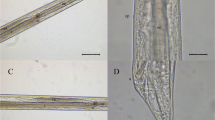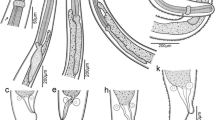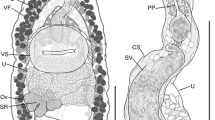Abstract
The taxonomy of Hysterothylacium genus in Mediterranean waters remains incomplete and unresolved. The aim of the current study was to investigate the morphological and molecular identification of selected species of Hysterothylacium larvae in marine fish from the Tunisian Mediterranean coasts. A total of 192 marine fish samples were examined. In total, thirty-seven third-stage larvae of Hysterothylacium were morphologically identified as Hysterothylacium type V. In the present study, representatives of this type from the Mediterranean Sea were genetically characterized for the first time by sequencing the rDNA ITS (ITS1-5.8S-ITS2) regions and mtDNA cox2 gene. This study represents the first report of Hysterothylacium type V from the Mediterranean Sea. We also report Mullus barbatus, M. surmuletus, and Pagellus erythrinus as new hosts for this larval type. Based upon molecular and phylogenetic analyses considering the rDNA ITS regions, the Hysterothylacium type V described here was classified as a new genotype, named Genotype B. The valid genetic data of the described Hysterothylacium type V in the present study can be used to establish the phylogenetic relationships among Hysterothylacium species from the Mediterranean Sea and worldwide for future research.



Similar content being viewed by others
References
Altschul SF, Gish W, Miller W, Myers EW, Lipman DJ (1990) Basic local alignment search tool. J Mol Biol 215:403–410
Amor N, Farjallah S, Merella P, Said K, Slimane BB (2011) Molecular characterization of Hysterothylacium aduncum (Nematoda: Raphidascaridae) from different fish caught off the Tunisian coast based on nuclear ribosomal DNA sequences. Parasitol Res 109:1429–1437
Angelucci G, Meloni M, Merella P, Sardu F, Madeddu S, Marrosu R, Franco P, Salati F (2011) Prevalence of Anisakis spp. and Hysterothylacium spp. larvae in teleosts and cephalopods sampled from waters off Sardinia. J Food Prot 74:1769–1775
Azizi R, Yemmen C, Bahri S (2017) Metazoan parasites of trachinid fishes (Teleostei: Trachinidae) from Tunisian coasts (Mediterranean Sea). Acta Adriat 58:209–224
Barcala E, Ramilo A, Ortega N, Picó G, Abollo E, Pascual S, Muñoz P (2018) Occurrence of Anisakis and Hysterothylacium larvae in commercial fish from Balearic Sea (Western Mediterranean Sea). Parasitol Res 117:4003–4012
Bezerra TN, Decraemer W, Eisendle-Flöckner U, Hodda M, Holovachov O, Leduc D, Miljutin D, Mokievsky V, Peña Santiago R, Sharma J, Smol N, Tchesunov A, Venekeym V, Zhao Z, Vanreusel A (2020) Nemys: world database of nematodes. Hysterothylacium Ward & Magath, 1917 World Wide Web Electronic Publication http:// wwwmarinespeciesorg/aphiaphp?p=taxdetails&id=19962. Accessed 26 April 2020
Bruce NL, Adlard RD, Cannon LRG (1994) Synoptic checklist of ascaridoid parasites (Nematoda) from fish hosts. Invertebr Taxon 8:583–674
Cannon LRG (1977) Some larval ascaridoids from south-eastern Queensland marine fishes. Int J Food Microbiol 7:233–243
Costa A, Graci S, Cammilleri G, Buscemi MD, Collura R, Vella A, Ferrantelli V (2018) Molecular identification of Hysterothylacium spp. in fishes from the Southern Mediterranean Sea (Southern Italy). J Parasitol 104:398–406
Deardorff TL, Overstreet RM (1981) Larval Hysterothylacium (=Thynnascaris) (Nematoda: Anisakidae) from fishes and invertebrates in the Gulf of Mexico. Proc Helminthol Soc Wash 48:113–126
Di Azevedo MIN, Iñiguez AM (2018) Nematode parasites of commercially important fish from the southeast coast of Brazil: morphological and genetic insight. Int J Food Microbiol 267:29–41
Farjallah S, Slimane BB, Blel H, Amor N, Said K (2006) Anisakid parasites of two forkbeards (Phycis blennoides and Phycis phycis) from the eastern Mediterranean coasts in Tunisia. Parasitol Res 100:11–17
Felsenstein J (1985) Confidence limits on phylogenies: an approach using the bootstrap. Evolution 39:783–791
Fonseca MCG, Knoff M, Felizardo NN, Di Azevedo MIN, Torres EJL, Gomes DC, Iñiguez AM, de São Clemente SC (2016) Integrative taxonomy of Anisakidae and Raphidascarididae (Nematoda) in Paralichthys patagonicus and Xystreurys rasile (Pisces: Teleostei) from Brazil. Int J Food Microbiol 235:113–124
Gazzonis AL, Cavallero S, Zanzani SA, Olivieri E, Malandra R, Ranghieri V, D’Amelio S, Manfredi MT (2017) Anisakis sp. and Hysterothylacium sp. larvae in anchovies (Engraulis encrasicolus) and chub mackerel (Scomber colias) in the Mediterranean Sea: molecular identification and risk factors. Food Contr 80:366–373
Ghadam M, Banaii M, Mohammed ET, Suthar J, Shamsi S (2018) Morphological and molecular characterization of selected species of Hysterothylacium (Nematoda: Raphidascarididae) from marine fish in Iraqi waters. J Helminthol 92:116–124
Gutiérrez-Galindo JF, Osanz-Mur AC, Mora-Ventura MT (2010) Occurrence and infection dynamics of anisakid larvae in Scomber scombrus, Trachurus trachurus, Sardina pilchardus, and Engraulis encrasicolus from Tarragona (NE Spain). Food Contr 21:1550–1555
Hillis DM, Bull JJ (1993) An empirical test of bootstrapping as a method for assessing confidence in phylogenetic analysis. Syst Biol 42:182–192
Hossen MS, Shamsi S (2019) Zoonotic nematode parasites infecting selected edible fish in New South Wales, Australia. Int J Food Microbiol 308:108306
Kalay M, Donmez AE, Koyuncu CE, Genc E, Sahin G (2009) Seasonal variation of Hysterothylacium aduncum (Nematoda: Raphidascarididae) infestation in sparid fishes in the Northeast Mediterranean Sea. Turk J Vet Anim Sci 33:517–523
Keskin E, Koyuncu CE, Genc E (2015) Molecular identification of Hysterothylacium aduncum specimens isolated from commercially important fish species of Eastern Mediterranean Sea using mtDNA cox1 and ITS rDNA gene sequences. Parasitol Int 64:222–228
Klimpel S, Kleinertz S, Palm HW (2008) Distribution of parasites from red mullets (Mullus surmuletus L., Mullidae) in the North Sea and the Mediterranean Sea. Bull Fish Biol 10:25–38
Knoff M, Felizardo NN, Iñiguez AM, Maldonado A Jr, Torres EJL, Pinto RM, Gomes DC (2012) Genetic and morphological characterisation of a new species of the genus Hysterothylacium (Nematoda) from Paralichthys isosceles Jordan, 1890 (Pisces: Teleostei) of the Neotropical Region, state of Rio de Janeiro, Brazil. Mem Inst Oswaldo Cruz 107:186–193
Kumar S, Stecher G, Li M, Knyaz C, Tamura K (2018) MEGA X: molecular evolutionary genetics analysis across computing platforms. Mol Biol Evol 35:1547–1549
MacKenzie K, Campbell N, Mattiucci S, Ramos P, Pinto AL, Abaunza P (2008) Parasites as biological tags for stock identification of Atlantic horse mackerel Trachurus trachurus L. Fish Res 89:136–145
Martín-Sánchez J, Díaz M, Artacho EM, Valero A (2003) Molecular arguments for considering Hysterothylacium fabri (Nematoda: Anisakidae) a complex of sibling species. Parasitol Res 89:214–220
Mattiucci S, Cipriani P, Levsen A, Paoletti M, Nascetti G (2018) Molecular epidemiology of Anisakis and Anisakiasis: an ecological and evolutionary road map. Adv Parasitol 99:93–263
Nadler SA, Hudspeth DS (2000) Phylogeny of the Ascaridoidea (Nematoda: Ascaridida) based on three genes and morphology: hypotheses of structural and sequence evolution. J Parasitol 86:380–393
Pantoja CS, Pereira FB, Santos CP, Luque JL (2016) Morphology and molecular characterization hold hands: clarifying the taxonomy of Hysterothylacium (Nematoda: Anisakidae) larval forms. Parasitol Res 115:4353–4364
Pekmezci GZ, Yardimci B, Onuk EE, Umur S (2014) Molecular characterization of Hysterothylacium fabri (Nematoda: Anisakidae) from Zeus faber (Pisces: Zeidae) caught off the Mediterranean coasts of Turkey based on nuclear ribosomal and mitochondrial DNA sequences. Parasitol Int 63:127–131
Petter AJ, Maillard C (1987) Ascarides de Poissons de Méditerranée occidentale. Bull Mus Natl Hist Nat 9:773–798
Petter AJ, Maillard C (1988) Larves d’ascarides parasites de poissons en Mediterranée occidentale. Bull Mus Natl Hist Nat 10:347–369
Reiczigel J, Rózsa L (2005) Quantitative Parasitology 3.0. Budapest
Rello FJ, Adroher FJ, Valero A (2008) Hysterothylacium aduncum, the only anisakid parasite of sardines (Sardina pilchardus) from the southern and eastern coasts of Spain. Parasitol Res 104:117–121
Rello FJ, Adroher FJ, Benítez R, Valero A (2009) The fishing area as a possible indicator of the infection by anisakids in anchovies (Engraulis encrasicolus) from southwestern Europe. Int J Food Microbiol 129:277–281
Roca-Geronès X, Montoliu I, Godínez-González C, Fisa R, Shamsi S (2018) Morphological and genetic characterization of Hysterothylacium Ward & Magath, 1917 (Nematoda: Raphidascarididae) larvae in horse mackerel, blue whiting and anchovy from Spanish Atlantic and Mediterranean waters. J Fish Dis 41:1463–1475
Roca-Geronès X, Segovia M, Godínez-González C, Fisa R, Montoliu I (2020) Anisakis and Hysterothylacium species in Mediterranean and North-East Atlantic fishes commonly consumed in Spain: epidemiological, molecular and morphometric discriminant analysis. Int J of Food Microbiol 325:108642
Rodríguez H, Bañón R, Ramilo A (2019) The hidden companion of non-native fishes in north-east Atlantic waters. J Fish Dis 42(7):1013–1021
Rózsa L, Reiczigel J, Majoros G (2000) Quantifying parasites in samples of hosts. J Parasitol 86:228–232
Serracca L, Cencetti E, Battistini R, Rossini I, Prearo M, Pavoletti E, Fioravanti ML, Righetti M, Di Donfrancesco BD, Ercolini C (2013) Survey on the presence of Anisakis and Hysterothylacium larvae in fishes and squids caught in Ligurian Sea. Vet Parasitol 196:547–551
Shamsi S (2017) Morphometric and molecular descriptions of three new species of Hysterothylacium (Nematoda: Raphidascarididae) from Australian marine fish. J Helminthol 91:613–624
Shamsi S, Gasser R, Beveridge I (2013) Description and genetic characterisation of Hysterothylacium (Nematoda: Raphidascarididae) larvae parasitic in Australian marine fishes. Parasitol Int 62:320–328
Shamsi S, Poupa A, Justine JL (2015) Characterisation of Ascaridoid larvae from marine fish off New Caledonia, with description of new Hysterothylacium larval types XIII and XIV. Parasitol Int 64:397–404
Shamsi S, Ghadam M, Suthar J, Ebrahimzadeh Mousavi H, Soltani M, Mirzargar S (2016) Occurrence of ascaridoid nematodes in selected edible fish from the Persian Gulf and description of Hysterothylacium larval type XV and Hysterothylacium persicum n. sp. (Nematoda: Raphidascarididae). Int J Food Microbiol 236:65–73
Shamsi S, Steller E, Chen Y (2018) New and known zoonotic nematode larvae within selected fish species from Queensland waters in Australia. Int J Food Microbiol 272:73–82
Simsek E, Ciloglu A, Yildirim A, Pekmezci GZ (2018) Identification and molecular characterization of Hysterothylacium (Nematoda: Raphidascarididae) larvae in bogue (Boops boops L.) from the Aegean Sea, Turkey. Kafkas Univ Vet Fak Derg 24:525–530
Tedesco P, Gustinelli A, Caffara M, Patarnello P, Terlizzi A, Fioravanti ML (2018) Hysterothylacium fabri (Nematoda: Raphidascarididae) in Mullus surmuletus (Perciformes: Mullidae) and Uranoscopus scaber (Perciformes: Uranoscopidae) from the Mediterranean. J Parasitol 104:262–274
Thompson JD, Higgins DG, Gibson TJ (1994) CLUSTAL W: improving the sensitivity of progressive multiple sequence alignment through sequence weighting, position-specific gap penalties and weight matrix choice. Nucleic Acids Res 22:4673–4680
Valero A, Paniagua MI, Hierro I, Díaz V, Valderrama MJ, Benítez R, Adroher FJ (2006) Anisakid parasites of two forkbeards (Phycis blennoides and Phycis phycis) from the Mediterranean coasts of Andalucía (Southern Spain). Parasitol Int 55:1–5
Vardić Smrzlić I, Valić D, Kapetanović D, Kurtović B, Teskeredžić E (2012) Molecular characterisation of Anisakidae larvae from fish in Adriatic Sea. Parasitol Res 11:2385–2391
Zhu X, Gasser RB, Podolska M, Chilton NB (1998) Characterization of anisakid nematodes with zoonotic potential by nuclear ribosomal DNA sequences. Int J Parasitol 28:1911–1921
Acknowledgments
This work is part of master thesis of Manel Khammassi defended at the Faculty of Sciences of Tunis in 2016. The molecular part was carried out during the internship of Ms. Manel at the Department of Aquatic Animal Diseases, Faculty of Veterinary Medicine, Ondokuz Mayis University Samsun-Turkey, supervised by Dr. Gokmen Zafer Pekmezci. We would like to thank to Associate Professor Didem Pekmezci (University of Ondokuz Mayis, Turkey), Professor Elyes Zhioua (Pasteur Institute of Tunis, Tunisia), and Ph.D. Oyku Naz Attila (University of Strathclyde, Glasgow, UK) for their help in English proofreading.
Author information
Authors and Affiliations
Corresponding author
Additional information
Section Editor: Shokoofeh Shamsi
Publisher’s note
Springer Nature remains neutral with regard to jurisdictional claims in published maps and institutional affiliations.
Rights and permissions
About this article
Cite this article
Khammassi, M., Bahri, S. & Pekmezci, G.Z. Morphological and molecular identification of Hysterothylacium larvae (Nematoda: Raphidascarididae) in marine fish from Tunisian Mediterranean coasts. Parasitol Res 119, 3285–3296 (2020). https://doi.org/10.1007/s00436-020-06848-4
Received:
Accepted:
Published:
Issue Date:
DOI: https://doi.org/10.1007/s00436-020-06848-4




